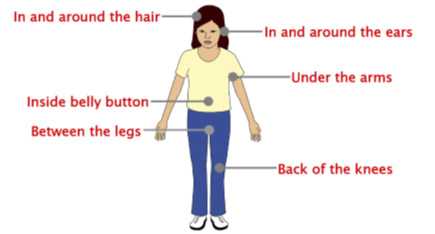Prevention
- There are no vaccines to prevent spotted fever infections. Prevent illness by preventing tick bites, preventing ticks on your pets, and preventing ticks in your yard.
- Ticks live in grassy, brushy, or wooded areas, or even on animals, so spending time outside camping, gardening, or hunting will bring you in close contact with ticks. Protect yourself, your family, and your pets. Here’s how:
- Know where ticks live. Most ticks prefer environments in or near wooded or grassy areas. You may come into contact with ticks during outdoor activities around your home or when walking through leaf litter or near shrubs. Always walk in the center of trails in order to reduce the chance of contacting ticks.
- Use DEET repellent on skin. When used as directed, repellents containing 20% or more DEET (N, N-diethyl-m-toluamide) can effectively help prevent tick bites. Repellents can provide up to several hours of protection and are safe and effective for everyone, including pregnant women and children. Always follow product instructions. Parents should apply this product to their children, avoiding the hands, eyes, and mouth. For detailed information about using DEET on children, see recommendations from the American Academy of Pediatrics.
- Treat clothing and gear with permethrin. Permethrin kills ticks and can be used to treat boots, clothing, and camping gear. Clothing treated with permethrin will provide lasting protection even after several washings.
- Treat your pets for ticks. Dogs are also prone to tick bites and can get tickborne diseases like RMSF. Tick collars, sprays, shampoos, or “top spot” medications should be used regularly to protect your animals and your family from ticks. Talk to your veterinarian and be sure to use these products according to the package instructions. For more information on animals and health, see Preventing Ticks on Your Pet.
- For detailed information about tick prevention and control, see the Avoiding Ticks page.
After You Come Indoors
-
- Check your clothing for ticks. Ticks may be carried into the house on clothing. Remove any ticks that you find.
- Check your dogs for ticks after returning from tick habitats. The most common location for ticks on dogs include the ears, arm pits, groin, around the paws, and in-between the toes.
- Shower soon after being outdoors. Showering within two hours of coming indoors can help wash off unattached ticks, and it is a good opportunity to do a tick check.
- Tumble dry clothes in a dryer on high heat for 10 minutes to kill ticks on dry clothing after you come indoors.
- If the clothes are damp, additional time may be needed.
- If the clothes require washing first, hot water is recommended. Cold and medium temperature water will not kill ticks effectively. If the clothes cannot be washed in hot water, tumble dry on low heat for 90 minutes or high heat for 60 minutes. The clothes should be warm and completely dry.
- Check your body for ticks after being outdoors. Check your body for ticks! If you have kids, check them for ticks. Use a mirror or have someone help you with hard-to-see areas. Ticks can be found anywhere, but are commonly found:

If You Find an Attached Tick
Remove any attached ticks from people or pets immediately. To remove a tick grasp it with tweezers, as close to the skin as possible, and pull it straight out. Do not twist or jerk. For detailed information about tick removal, see the Tick Removal page.
Watch for signs of illness in people and pets after spending time in tick-infested habitats, even if you don’t remember a tick bite. Spotted fevers, including RMSF, can be treated effectively with doxycycline if caught early, so see your health care provider immediately if you develop a fever, rash, or flu-like symptoms. Be sure to tell your health care provider if you have been bitten by a tick in the last 2 weeks or if you have been outdoors where you might have been in contact with ticks.
- Page last reviewed: April 13, 2017
- Page last updated: April 13, 2017
- Content source:


 ShareCompartir
ShareCompartir